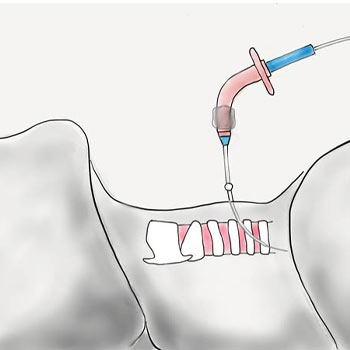Percutaneous Tracheostomy
- Home
- Services
- Pulmonology
- Percutaneous Tracheostomy
What is Percutaneous Tracheostomy?
A percutaneous tracheostomy is a medical procedure where an opening is created directly into the trachea (windpipe) through the neck to facilitate breathing. Unlike a traditional surgical tracheostomy, which involves a larger incision and is performed in an operating room, a percutaneous tracheostomy is less invasive and can often be performed at the patient's bedside. This procedure is particularly useful in critical care settings, such as intensive care units (ICUs), for patients who require long-term mechanical ventilation.
Indications for Percutaneous Tracheostomy
Percutaneous tracheostomy is indicated for several conditions, including
Prolonged Mechanical Ventilation
Patients who need extended ventilatory support, typically beyond 7-10 days, benefit from a tracheostomy to reduce the risk of complications associated with prolonged endotracheal intubation.
Airway Obstruction
Conditions such as tumors, trauma, or severe swelling that obstruct the upper airway may necessitate a tracheostomy to ensure an open airway
Neurological Impairment
Patients with severe neurological conditions, such as stroke or traumatic brain injury, that impair their ability to protect their airway or breathe effectively may require a tracheostomy
Pulmonary Conditions
Severe respiratory diseases like chronic obstructive pulmonary disease (COPD) or acute respiratory distress syndrome (ARDS) that necessitate long-term ventilation support.

Benefits of Percutaneous Tracheostomy
Percutaneous tracheostomy offers several advantages over traditional surgical tracheostomy
- Less Invasive: The procedure involves smaller incisions and less tissue dissection, resulting in reduced trauma and faster recovery
- Bedside Procedure: Percutaneous tracheostomy can be performed at the patient's bedside in the ICU, eliminating the need for transportation to the operating room and reducing associated risks.
- Reduced Complications: There is a lower risk of infection, bleeding, and scarring compared to surgical tracheostomy
- Improved Patient Comfort: Patients with tracheostomies often experience less discomfort and better tolerance compared to those with endotracheal tubes
Post-Procedural Care
Proper care and management of the tracheostomy are crucial for preventing complications and ensuring optimal outcomes. Post-procedural care includes
- Tracheostomy Tube Maintenance: Regular cleaning and suctioning of the tracheostomy tube and surrounding area to prevent blockages and infections
- Monitoring for Complications: Frequent assessment for signs of infection, bleeding, or tube displacement
- Humidification: Providing humidified air to prevent drying of the tracheal mucosa and secretions
- Speech and Swallowing Support: Patients with tracheostomies may require speech and swallowing therapy to regain these functions
- Weaning from Ventilation: Gradual reduction in ventilatory support and potential decannulation (removal of the tracheostomy tube) as the patient’s condition improves
Percutaneous tracheostomy is a valuable procedure in the management of patients requiring long-term ventilation support. Its minimally invasive nature, ability to be performed at the bedside, and reduced complication rates make it a preferred choice in many critical care settings. Proper patient selection, skilled execution, and diligent post-procedural care are essential for achieving the best outcomes and minimizing risks.
